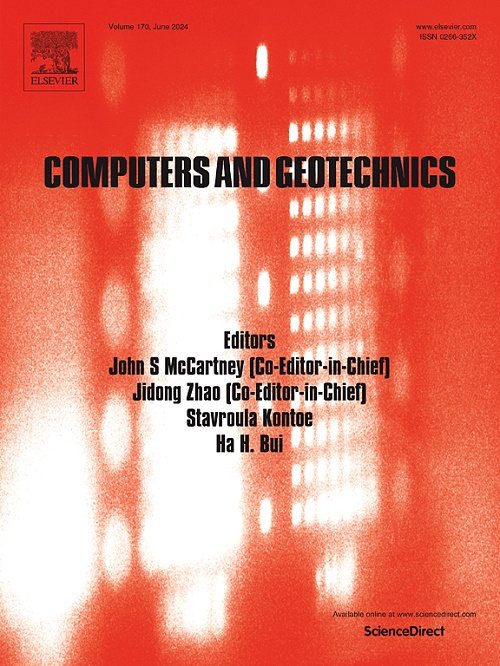Rate-dependent FDEM numerical simulation of dynamic tensile fracture and failure behavior in frozen soil
IF 5.3
1区 工程技术
Q1 COMPUTER SCIENCE, INTERDISCIPLINARY APPLICATIONS
引用次数: 0
Abstract
Considering that the dynamic fracture and failure behaviors of frozen soil play a crucial role in the safety and stability of engineering foundations in cold regions, this study aimed to reveal the dynamic tensile mechanical properties and damage failure mechanisms of frozen soil under impact loading. Dynamic Brazilian disk (BD) tests were conducted on frozen soil at different temperatures and loading velocities using a split Hopkinson pressure bar (SHPB) apparatus, followed by numerical simulations using the finite discrete element method (FDEM), focusing on the dynamic tensile deformation characteristics, failure patterns, tensile strength, and energy dissipation mechanisms of the frozen soil. The experimental results indicated that the dynamic tensile mechanical properties of frozen soil were influenced by both temperature and loading velocity. As the temperature decreased and loading velocity increased, the tensile strength of frozen soil significantly increased and showed a linear correlation with the loading velocity. At lower loading velocities, the cracks tended to propagate along the paths of least resistance, forming fewer but longer macrocracks. With increasing loading velocities, the number of cracks markedly increased, and their distribution became more diffuse, leading to a greater extent of failure in the frozen soil. An exponential damage cohesive interface model that considers rate effects was proposed to describe the dynamic tensile fracture mechanical behavior of frozen soil accurately. This model addresses the rate sensitivity of frozen soil and effectively accounts for the temperature effect by considering the volume of ice content and cryogenic suction. A comparison of the FDEM numerical simulation results with the experimental data indicated a good consistency in the overall trends, thus validating the effectiveness and applicability of the FDEM in simulating the dynamic tensile mechanical behavior of frozen soil.
冻土动态拉伸断裂破坏行为的速率相关FDEM数值模拟
考虑到冻土的动态断裂破坏行为对寒区工程基础的安全稳定起着至关重要的作用,本研究旨在揭示冻土在冲击荷载作用下的动态拉伸力学特性和损伤破坏机制。采用分离式霍普金森压杆(SHPB)装置对不同温度和加载速度下的冻土进行了动态巴西盘(BD)试验,并采用有限离散元法(FDEM)进行了数值模拟,重点研究了冻土的动态拉伸变形特征、破坏模式、抗拉强度和能量耗散机制。试验结果表明,冻土的动态拉伸力学特性受温度和加载速度的共同影响。随着温度的降低和加载速度的增加,冻土的抗拉强度显著增加,且与加载速度呈线性相关。在较低加载速度下,裂纹倾向于沿阻力最小的路径扩展,形成较少但较长的宏观裂纹。随着加载速度的增加,裂缝数量显著增加,且分布更加分散,导致冻土破坏程度增大。为了准确描述冻土的动态拉伸断裂力学行为,提出了考虑速率效应的指数损伤黏结界面模型。该模型解决了冻土的速率敏感性问题,并通过考虑含冰量和低温吸力,有效地解释了温度效应。FDEM数值模拟结果与实验数据的对比表明,总体趋势具有较好的一致性,从而验证了FDEM在模拟冻土动态拉伸力学行为方面的有效性和适用性。
本文章由计算机程序翻译,如有差异,请以英文原文为准。
求助全文
约1分钟内获得全文
求助全文
来源期刊

Computers and Geotechnics
地学-地球科学综合
CiteScore
9.10
自引率
15.10%
发文量
438
审稿时长
45 days
期刊介绍:
The use of computers is firmly established in geotechnical engineering and continues to grow rapidly in both engineering practice and academe. The development of advanced numerical techniques and constitutive modeling, in conjunction with rapid developments in computer hardware, enables problems to be tackled that were unthinkable even a few years ago. Computers and Geotechnics provides an up-to-date reference for engineers and researchers engaged in computer aided analysis and research in geotechnical engineering. The journal is intended for an expeditious dissemination of advanced computer applications across a broad range of geotechnical topics. Contributions on advances in numerical algorithms, computer implementation of new constitutive models and probabilistic methods are especially encouraged.
 求助内容:
求助内容: 应助结果提醒方式:
应助结果提醒方式:


